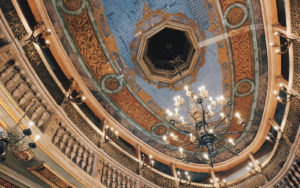Traditional recipes from the Jewish Ghetto: kosher cuisine in Venice
Venice’s Jewish Ghetto offers plenty of specialties that originated from the combination of the lagoon gastronomic tradition with the Jewish one. An unexpected culinary experience beyond the well-known bacari.
The origin of the Jewish Ghetto
It is not clear when exactly the Jews first came to Venice, but their presence has for sure ancient origins, dating back to just a few years before 1000 AD. At an early stage Venice was quite tolerant of the Jews, but towards the end of the 14th century, new restrictions drastically impacted their freedom. However, the year that marked the history of the Jewish Community in Venice was 1516, when the Serenissima Republic relegated the Jews to the foundry district.
A curiosity: the word ghetto was born right in Venice and derives from geto, which in Venetian dialect meant the casting of molten metal. Many of the Jews came from Central and Eastern Europe and pronounced the word with a hard “g”, thus transforming it into gheto. Venice’s Jewish Ghetto is the oldest in the world and is located in the Cannaregio district, between the Ponte delle Guglie and Fondamenta degli Ormesini.
The basics of kosher cuisine
The term kosher means “suitable”, and therefore respectful of the laws of the Torah. The preparations conforming to the principles of this cuisine involve the consumption of animals considered pure, specifically animals with split hooves and ruminants. As for poultry meat, chicken, turkey, goose and duck are allowed. In any case, the slaughter of the meat must take place according to specific rules. It is also allowed to eat fish, as long as it has bones and fins.
Kosher cuisine has been affected by two traditions: the Spanish Sephardic and the East German Ashkenazi. From the first it inherited the preparations of desserts and starchy foods, from the second its love for spices.

Recipes you should definitely try
Over nearly three centuries of life, the Jewish Ghetto saw an interesting contamination between Venetian and Jewish cuisine. The Venetians, in fact, used to go to the Ghetto to pawn objects and do some shopping so, inevitably, the cuisines influenced each other.
The results of this combination include some of the most famous dishes of the Venetian cuisine, such as the famous and appreciated sardines in saor and bigoli in salsa, a typical kind of pasta seasoned with an onion and anchovy sauce.
How not to mention, among the most typical dishes of kosher cuisine, the fugazza cole gribole, a soft bread mixed with pieces of fried goose skin and zalo rice, prepared with saffron and served with raisins and pumpkin. Then there is also the goose luganegotto, a fatty flavored salami, and the knodel prepared with pieces of goose salami, similar to the Tyrolean dish in broth.
Among the delicacies, we also mention buriche, small panzerotti of shortcrust pastry, baked or fried and stuffed with meat, onion and pine nuts. Among the desserts you should try the ears of Amman, triangular biscuits filled with jam or chocolate and dried fruit.
What to see in the Jewish Ghetto
The area of the Jewish Ghetto is particularly interesting, not only on a gastronomic level. First of all, we suggest a visit to the Jewish Museum, founded in 1954 by the Venetian Jewish Community. In the same building you can also visit the oldest synagogue of the Ashkenazi Jews. At the corner of the square is the Canton synagogue and, not far away, the Schola Italiana.
Don’t be surprised if you don’t recognize the synagogues from the outside: they are always located on the top floor of the building. This is because, according to the Jewish religion, “there can be nothing earthly above the synagogue”.




